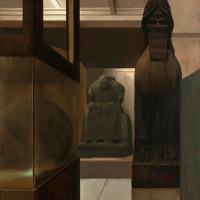52. RICK AMOR The Silence

Amors paintings have a distinctive mood an autumnal wistfulness. They often present a world that is haunted rather than peopled and they always seem to be created by a displaced witness a Hitchcockian suspense pervades his paintings. Furthermore there is, in Amors paintings, often a feeling of belatedness, in the sense used by Harold Bloom, the American literary critic and Sterling Professor of Humanities at Yale University, that lends to his works the character of coming late to the scene, of arriving just after important things have occurred. Not surprisingly, these twin attributes, belatedness and dislocated witness, are crucially important components of the enigmatic elements that pervade so many of Amors paintings and in part account for their memorable and psychologically pregnant atmospheres. Amor is a deeply ruminative artist who takes his aesthetic purpose very seriously and tries to select and depict significant, and often poetic, moments gleaned on his travels, his trawling through buildings and his meanderings through lanes, arcades, walkways and alleys described by him as the innards of a city. His one- time mentor, the well-known Melbourne artist John Brack often remarked to him that if he could not find a lifetimess artistic subject matter within a kilometre of home, he could not become an artist. Thereafter, Amor became an artist of locality.
Amors oil on canvas painting The Silence of 2001 is one of his finest works and it exemplifies some of the best qualities of his mature phase. The painting presents a view of a gallery of antiquities, probably Londons British Museum or Melbournes old Museum in Swanston Street, which Amor used to visit as a teenager and where he was a student from 1966 to 1968. It shows a section of a room with what appears to be an Assyrian tomb sculpture with an adjoining headless sitting figure. The suffused light is penumbral and the room is only partially lit. The painting uses a deliberately limited palette with colours that range from ochres, umber and sienna to grey. Amors painting has the dusk-like stillness and pictorial presence that emerge in the paintings of the Belgian artist Paul Delvaux and the Polish/French artist Balthus, both of them much admired by the artist. The pictorial space is recessional, though shallow, and the viewers eye is kept within the bounds of the picture by two receding planes placed on either side of the canvas, to focus the eye of the viewer and to heighten the pictorial drama. The atmosphere of the painting is solemn and reserved, an enigmatic quality pervades the atmosphere of the scene and intimations of the renowned Italian Pittura Metafisica (Metaphysical Painting) artist Giorgio de Chirico flood the work.
Amors painting The Silence of 2001 is related to two significant earlier paintings. The Silent Hour of 1999 shows a storage room of a museum with a large skull of a mammoth placed on a stand in an unpeopled space- multiple soft light sources give the room an eerie glow and a sense of quietude. Amors painting The Quiet Days of 1998 to 1999 is bathed in a similar light and is based upon the very impressive stairs that lead to the first floor of the State Library of Victoria. The painting emanates gravity and restraint and the works pensiveness recall the justly famous paintings of the Swiss artist Arnold Bcklin (1827-1901).
Amors briefly perceived glimpses give his paintings a temporal ambience as though the scene is captured in the blink of an eye while being isolated and removed from it. Amor is not simply an impassive observer of local realities; he is an active and avid collector and a manipulator of carefully selected visual details that channel ones vision and construct pictorial meaning. Amor is an artist of gravitas. His painting The Silence is a culmination of all the tenebrous qualities that exist in his earlier works and it presents the artist at his most characteristic and best.
Literature
Catalano, C., The Solitary Watcher: Rick Amor and his Art, The Miegunyah Press, Melbourne University press, 2001
Payes, S., United: Portraits of Australian Artists, Macmillan Publishing, Melbourne, 2007
Lindsay, R., Rick Amor: Standing in the Shadows, McClelland Art Gallery, Melbourne, 2005
Making Portraits: Five Years of National Portrait Gallery commissions, National Portrait Gallery, Canberra, 2004
Rick Amor: Commemorating 20 years with Niagara Galleries, exhibition catalogue, 2003
Associate Professor Ken Wach
Dip. Art; T.T.T.C.; Fellowship RMIT; MA; PhD.
Former Principal Research Fellow and Head,
School of Creative Arts
The University of Melbourne